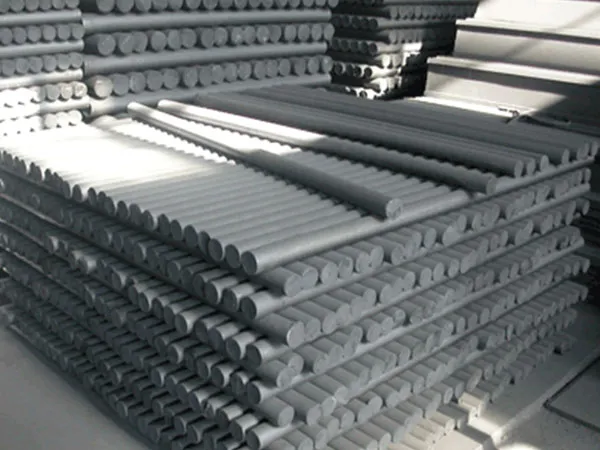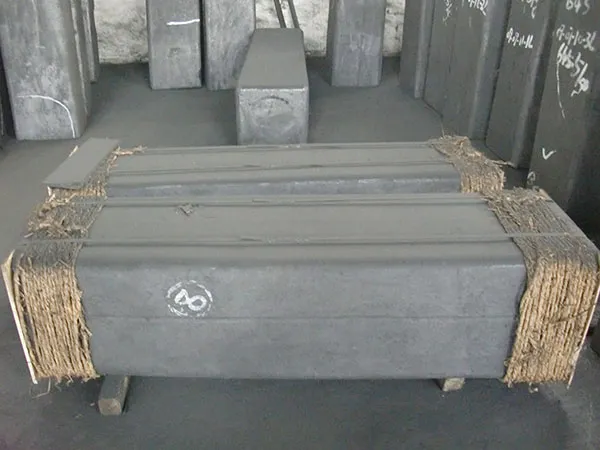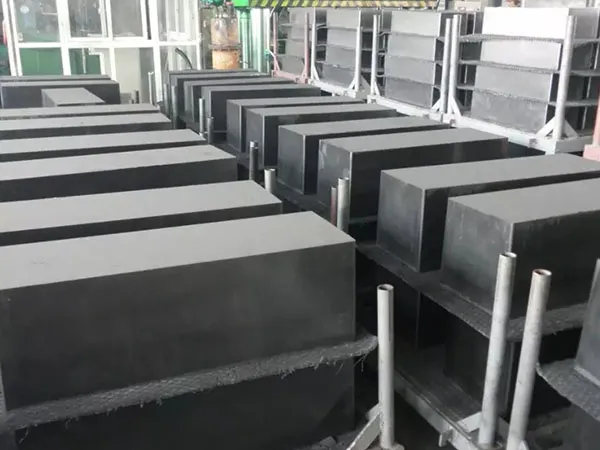Time: 2025-04-07 01:53:50 Source: Cangzhou Carbon Technology Co., Ltd.
When selecting graphite materials, two popular types are extruded graphite and molded graphite. While both are synthetic graphites, they differ significantly in terms of manufacturing process, grain size, mechanical properties, and common applications.
Both are types of synthetic graphite made from petroleum coke and coal tar pitch binder, but their manufacturing processes lead to significant differences in structure, properties, and applications.

Extruded Graphite:
Process: A mixture of calcined petroleum coke (filler) and coal tar pitch (binder) is heated to make it plastic. This hot, semi-solid mix is then forced (extruded) through a die with a specific cross-sectional shape (e.g., round, square, rectangular). Think of it like squeezing toothpaste from a tube or extruding aluminum profiles.
Result: Produces long, continuous shapes like rods, blocks, or tubes.
Molded Graphite:
Process: The coke and pitch mixture (often using finer coke particles than extrusion) is placed into a mold cavity. High pressure is then applied to compact the material into the desired shape. This pressure can be:
Uniaxial/Biaxial: Applied from one or two directions (like pressing powder in a die).
Isostatic (Isotropic): Applied uniformly from all directions, typically using hydrostatic pressure (fluid pressure in a chamber). This is often referred to as "iso-molded" or "isostatically pressed" graphite.
Result: Produces discrete parts or blocks within the confines of the mold. Isostatic molding creates billets that are then machined.
Extruded Graphite:
Structure: The extrusion process tends to align the graphite particles (coke grains) parallel to the direction of extrusion.
Isotropy: This alignment makes the graphite anisotropic. Its properties (like strength, thermal conductivity, electrical resistivity) are different when measured parallel versus perpendicular to the extrusion direction (grain).
Molded Graphite:
Structure:
Uniaxial/Biaxial Molding: Some particle alignment can occur perpendicular to the pressing direction. Still somewhat anisotropic, though often less so than extruded.
Isostatic Molding: The uniform pressure results in a more random orientation of particles.
Isotropy:
Uniaxial/Biaxial Molding: Moderately anisotropic.
Isostatic Molding: Produces graphite that is largely isotropic, meaning its properties are nearly uniform in all directions. This is a key advantage for many applications.

Extruded Graphite:
Generally has larger grain sizes.
Lower density compared to iso-molded graphite.
Properties vary with direction (anisotropic).
Often lower strength compared to fine-grain molded grades.
Molded Graphite:
Can be made with much finer grain sizes.
Can achieve higher and more uniform densities (especially iso-molded).
Properties are more uniform (isotropic), especially for iso-molded grades.
Often exhibits higher strength, better wear resistance, and finer surface finishes after machining (especially fine-grain, iso-molded grades).
Extruded Graphite: Well-suited for producing large cross-sections and long lengths (e.g., large electrodes, long rods).
Molded Graphite: Can produce more complex near-net shapes (uniaxial/biaxial) or large, uniform blocks/rounds (isostatic) that are subsequently machined into intricate parts.
Extruded Graphite: Generally less expensive due to the potential for continuous production and often less stringent processing requirements.
Molded Graphite: Often more expensive, especially fine-grain, high-density, iso-molded grades, due to more complex batch processing, tooling costs, and potentially higher raw material quality.
Extruded Graphite:
Large electrodes for electric arc furnaces (EAF) in steelmaking.
Furnace linings and structural components.
Heat exchangers.
Continuous casting dies (often).
Anodes for aluminum smelting (though typically use a different process path).
Molded Graphite (especially Isostatic):
EDM (Electrical Discharge Machining) electrodes (requires fine detail).
Semiconductor manufacturing (crucibles, susceptors, heaters - requires purity, fine grain, isotropy).
Continuous casting dies (high-performance).
Mechanical applications (seals, bearings, bushings - requires wear resistance, fine grain).
Rocket nozzles.
Hot pressing dies.
Nuclear reactor components.

Feature
Extruded Graphite
Molded Graphite (esp. Isostatic)
Process
Forced through a die
Pressed within a mold
Grain Align.
Parallel to extrusion
More random (esp. Iso)
Isotropy
Anisotropic (Directional props.)
Can be Much Finer
Grain Size
Generally Larger
Can be Higher & More Uniform
Density
Generally Lower
Often Higher
Strength
Lower (esp. across grain)
Often Better (finer finish)
Machinability
Good
Discrete parts, complex shapes, blocks
Shapes
Long lengths, constant cross-section
Generally Higher
Cost
Generally Lower
Generally Higher
Primary Use
Large electrodes, structural
High performance, fine detail, isotropy
The choice between extruded and molded graphite depends entirely on the requirements of the specific application, balancing factors like required properties (isotropy, strength, density), size, shape complexity, and cost.